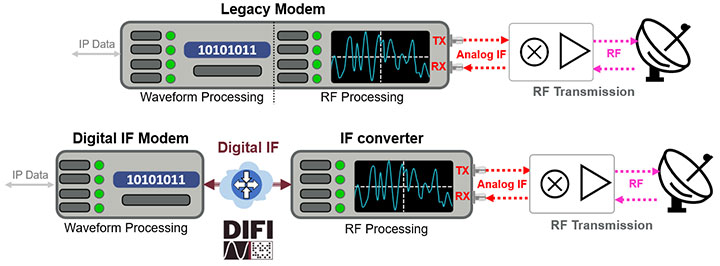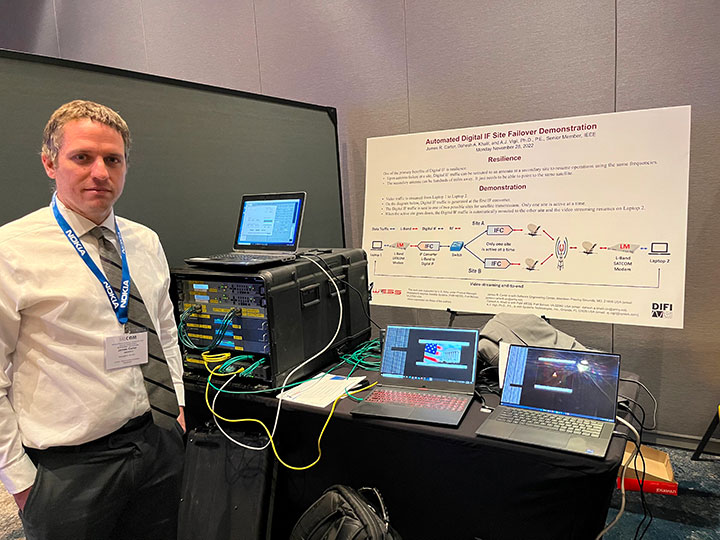By: Dr. Juan Deaton — May 31, 2023
MOSCOW, Idaho — Over a decade ago, Dr. A.J. Vigil wrote a 2009 MILCOM paper that proposed replacing analog Intermediate Frequency (IF) signals using a technique called digital IF. The paper was met with skepticism and nearly rejected since the need for digital IF was poorly understood, considered unnecessary and irrelevant.
Today, Vigil supports the Product Manager, Wideband Enterprise Satellite Systems (PdM WESS), the U.S. Army office responsible for the acquisition, fielding and lifecycle sustainment of strategic satellite communication for the Department of Defense. He is also an active member of the Digital IF Interoperability Consortium, which has grown to more than 50 industry and government organizations since its founding in 2021.
“When I originally proposed digital IF all those years ago, it was about growth. I had not even realized yet its immense potential to deliver network resilience. It is fantastic now to see wide industry support for the DIFI Standard and the hard work and dedication of so many DIFI consortium members,” Vigil said.
In the same way that streaming video revolutionized cable TV, digital IF is replacing analog coaxial lines with IP-switched fiber. Coaxial lines are limited to distances of around 1,000 feet due to signal loss and distortion, but DIFI IP-switched fiber can support distances of up to 40 km with commercial hardware.
“For all our gateways, our service demand was growing so quickly that our analog switching systems would constantly be breaking the bank. Digital IF became the only way to modernize these facilities and, at the same time, meet our service demand and build a resilient network architecture,” said Dave Khalil, Lead Systems Engineer of PdM WESS.
According to Vigil and Khalil’s latest 2022 MILCOM paper, data traffic throughput is growing at a 20-22% compound annual growth rate, and the bottleneck to these gateway expansions is the analog switching capacity.
 DIFI is the protocol that will provide interoperability between different vendors’ digital IF modems and IFC. (Source: Juan Deaton)
DIFI is the protocol that will provide interoperability between different vendors’ digital IF modems and IFC. (Source: Juan Deaton)
Digital IF enables the transmission of digital samples using IP network packets, separating legacy modem waveform processing and Radio Frequency (RF) processing into two components: the digital IF modem and the IF Converter (IFC). This separation permits the utilization of common hardware for digital IF modems and isolates specialized RF hardware in the IFC. In a digital IF gateway, digital IF modem banks are interconnected to multiple digital IFC transmission systems through IP-based network switches using the DIFI protocol. These DIFI links are the foundation for network agility and resilience.
At the DIFI Consortium’s Digital Transformation of SATCOM special workshop at MILCOM 2022 in Rockville, Md., James Carter, supporting PdM WESS, showcased how digital IF can increase network resilience by automatically switching transmissions between antenna sites. Carter’s work titled Automated Digital IF Site Failover Demonstration showed that digital IF traffic can be routed using an IP switch to a secondary site’s IFC and antenna to resume operations upon an antenna failure at a primary site. Through IP-switched hardware, routing of digital IF traffic to other sites—even miles away—can be performed quickly or automatically, reducing outages from potentially hours or days to seconds. This way, digital IF traffic sent to sites experiencing faults due to severe weather, interference or physical damage can continue without significant interruption.
 Jimmy Carter and the digital IF failover demonstration at MILCOM 2022. (Source: Juan Deaton)
Jimmy Carter and the digital IF failover demonstration at MILCOM 2022. (Source: Juan Deaton)
To Khalil, digital IF routing is a real-world application to support resilience. “If we digitize the IF carrier, that means we can take that carrier to another antenna that’s looking at that same satellite, and we can get the traffic across. So, if anything happens to any antenna with digital IF, we can back up that traffic and send it seamlessly through another transmission.”
While experiments in this area are ongoing, PdM WESS is also helping advance and mature the technology by partnering with industry.
Through experimentation with multiple vendors’ IFC equipment at the Tobyhanna Army Depot (TYAD) Prototype, Integration, Test, and Training (PITT) lab, PdM WESS is prototyping digital IF for Army deployment. The PITT lab is exploring the capabilities of digital IF via experiments with multiple vendors’ digital IF modems, IFCs, analysis equipment, L-band modems, vector network analyzers and Ethernet switches. PdM WESS has purchased five models of IFCs from four vendors to evaluate the performance of the equipment. Throughout these evaluations, PdM WESS provides feedback to vendors’ product lines to develop improvements and additional features.
 TYAD SATCOM compound and digital IF equipment racks. (Source: TYAD MILCOM 2022 Poster)
TYAD SATCOM compound and digital IF equipment racks. (Source: TYAD MILCOM 2022 Poster)
While engaging vendors through the PITT lab, PdM WESS is also providing the catalyst for developing digital IF modem capabilities through the Enterprise Digital IF Multi-Carrier (EDIM) modem program. The EDIM modem will provide millions of dollars in funding for digital IF modem development using the DIFI standard. The EDIM program, which accepted proposal submissions this January, will announce a proposal winner later this year.
While experiments and programs to build resilient ground networks continue, significant technical challenges remain for the full-scale deployments of digital IF. “Understanding how to delicately manage trade-offs between waveform performance and digital IF terrestrial network capacity requires more study,” said Mark Jasen, DIFI board member and President of the Genus Group.
Given that a DIFI link carrying 500 MHz digital IF of bandwidth can exceed 10 Gbps of data throughput, there is a need for higher capacity networks and management techniques. Given these excessive throughput needs, networks with hundreds of links could encounter network congestion. “The DIFI standard will require features to cope with congestion to address latency, jitter, packet loss, or even out-of-order packets,” Jasen added. Network congestion can create severe problems, such as losing modem lock and dropping communication for seconds.
While the DIFI protocol has parameters to reduce data throughput, that throughput reduction can come at the expense of signal quality and affect user data rates. According to its roadmap, the DIFI consortium will begin addressing link establishment and negotiation in version 1.3, targeted for December 2023. In the meantime, the DIFI consortium is working to release version 1.2 of the standard at the end of June.
About the Author
Dr. Juan Deaton is the Chief Alignment Officer at Alignment Consulting and Engineering (ACE), a research scientist and thought leader in digital IF satellite technology.
Explore More:
Podcast: Interoperability, Open Standards and the Next Level of Flexibility
Does Bandwidth Optimization Still Matter? Less and Less
DIFI Advances Digital IF Standards for Ground Interoperability
